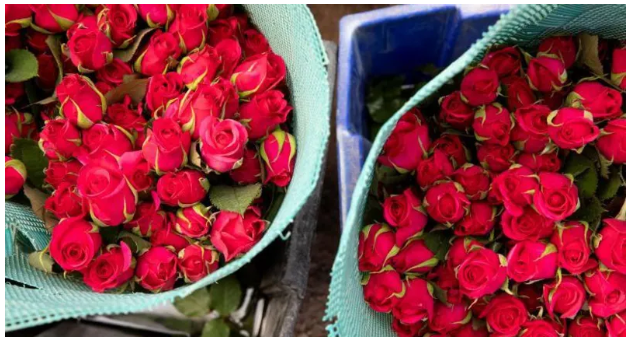
In the verdant highlands of Naivasha, Kenya, where the morning mist rises over acres of greenhouses, thousands of workers bend over rows of vibrant roses, their hands stained from hours of picking and trimming. Every day, these workers most of them women labor under the blistering sun or in humid, greenhouse conditions, ensuring that fresh roses will make their way to Europe’s markets, filling vases and brightening rooms.
Kenya is one of the world’s largest exporters of cut flowers, with roses being the crown jewel of the industry. The country supplies about a third of all the roses sold in Europe, a multi-billion-dollar trade that fuels the economies of rural communities. But behind the beauty of these delicate blooms lies a stark contrast: the lives of the workers who spend long hours harvesting, sorting, and packaging the flowers before they embark on their journey across continents.
For many workers, the day begins before sunrise. Maria, a 35-year-old mother of three, rises at 4 a.m. to prepare for her shift at a flower farm in Naivasha. She works a grueling 12-hour day, earning barely enough to cover basic needs like food, rent, and school fees for her children. “The work is hard, but there are no other options,” she says as she picks thorn-covered roses, her fingers cracked and swollen from handling chemicals used to preserve the flowers.
The use of pesticides and fertilizers, while essential to maintaining the pristine quality of the roses, comes at a significant cost to the health of workers. Without adequate protective gear, many laborers are exposed to harmful chemicals that cause respiratory issues, skin irritations, and even long-term illnesses. Medical care is sparse, and for many, the risks of working on the farms are outweighed by the need to provide for their families.
The industry itself is a well-oiled machine, designed to meet the insatiable demand for fresh flowers, especially during peak seasons like Valentine’s Day and Mother’s Day. In these periods, the pace of work intensifies as flower farms scramble to meet orders from European supermarkets, florists, and online retailers. Planes filled with millions of stems take off from Nairobi’s airport, bound for the flower auctions in the Netherlands, the nerve center of Europe’s floral trade.
However, the glamour of Europe’s flower markets, with their perfectly arranged bouquets and competitive prices, hides the low wages and harsh conditions endured by Kenyan workers. Many earn around $2 a day, barely enough to survive in the increasingly expensive rural areas surrounding the farms. Housing is often substandard, with whole families crammed into tiny rooms without running water or electricity.
Despite these challenges, the flower industry remains the lifeblood of the local economy. It employs an estimated 100,000 people directly, with thousands more benefiting from the ancillary businesses it supports. In towns like Naivasha, nearly everything revolves around the flower farms: small businesses sell food to workers, schools cater to their children, and health clinics though underfunded treat illnesses tied to farm work.
 Yet, while the economic benefits of the industry are undeniable, so too are the systemic issues plaguing it. Labor rights activists have long called for better wages, safer working conditions, and healthcare provisions for workers. Some progress has been made, with a few farms now offering health insurance and maternity leave, but these benefits are often limited to a select few.
Yet, while the economic benefits of the industry are undeniable, so too are the systemic issues plaguing it. Labor rights activists have long called for better wages, safer working conditions, and healthcare provisions for workers. Some progress has been made, with a few farms now offering health insurance and maternity leave, but these benefits are often limited to a select few.
Moreover, climate change is now posing a new threat to the flower industry. Kenya’s highlands, once blessed with steady rains and fertile soil, are becoming increasingly arid. The lack of water has forced many farms to tap into Lake Naivasha, depleting the lake’s water levels and threatening local ecosystems. Conservationists have raised concerns that, without sustainable water management, both the flower industry and the environment will suffer devastating consequences in the near future.
Despite the hardships, workers like Maria find small moments of pride in their work. I see the pictures of our flowers in European shops, and I think, ‘I helped grow that, she says. But her smile fades as she returns to the reality of her situation an unending cycle of labor, for a wage that offers little hope for a better future.
As Europe’s consumers admire their bouquets, few are aware of the sweat and sacrifice it takes to grow these flowers. The beauty of the roses belies the harsh lives of the people who make it all possible, toiling away on the farms so that fresh blooms can grace dining tables, weddings, and special occasions thousands of miles away.
This is the untold story of Kenya’s flower farms a world where beauty is cultivated through hardship, and where the sweetness of fresh roses is tinged with the bittersweet reality of those who make it all possible.
This narrative sheds light on the unseen labor and challenges faced by the workers behind Kenya’s booming flower industry, which supplies a significant portion of Europe’s demand for fresh roses. It explores issues of labor rights, environmental sustainability, and the economic lifeline the industry provides, all while revealing the stark contrasts between the world of the rose farms and the markets they serve.
Ennywealth


